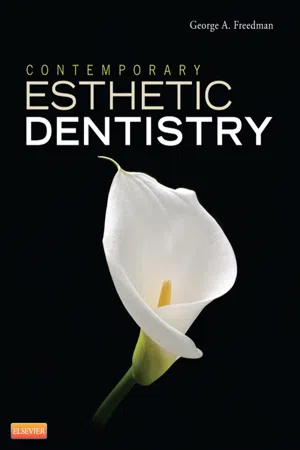
- 832 pages
- English
- ePUB (mobile friendly)
- Available on iOS & Android
Contemporary Esthetic Dentistry
About This Book
Covering both popular and advanced cosmetic procedures, Contemporary Esthetic Dentistry enhances your skills in the dental treatments leading to esthetically pleasing restorations. With over 1, 600 full-color illustrations, this definitive reference discusses the importance of cariology and caries management, then covers essential topics such as ultraconservative dentistry, color and shade, adhesive techniques, anterior and posterior direct composites, and finishing and polishing. Popular esthetic treatment options are described in detail, including bleaching or tooth whitening, direct and porcelain veneers, and esthetic inlays and onlays. Coverage of advanced cosmetic procedures includes implants, perioesthethics, ortho-esthetics, and pediatric esthetics, providing a solid understanding of treatments that are less common but can impact patient outcomes. Developed by Dr. George A. Freedman, a renowned leader in the field, Contemporary Esthetic Dentistry also allows you to earn Continuing Education credits as you improve your knowledge and skills.
- Continuing Education credits are available, allowing you to earn one to two CE credits per chapter.
- Detailed coverage of popular esthetic procedures includes bleaching, direct and porcelain veneers, inlays and onlays, posts and cores, porcelain-fused-to-metal restorations, zirconium crowns and bridges, and complete dentures.
- Coverage of advanced procedures includes implants, perioesthethics, ortho-esthetics, pediatric esthetics, and sleep-disordered breathing, providing a solid understanding of less-frequently encountered topics that impact the esthetic treatment plan and outcomes.
- Coverage of key esthetic dentistry topics and fundamental skills includes cariology and caries management, understanding dental materials, photography, understanding and manipulating of color and shade, adhesive techniques, anterior and posterior direct composites, and finishing and polishing.
- Over 1, 600 full-color photos and illustrations help to clarify important concepts and techniques, and show treatments from beginning of the case to the final esthetic results.
- Well-known and respected lead author George A. Freedman is a recognized author, educator, and speaker, and past president of the American Academy of Cosmetic Dentistry and co-founder of the Canadian Academy for Esthetic Dentistry.
- Expert contributors are leading educators and practicing clinicians, including names such as Irvin Smigel (the father of esthetic dentistry), Chuck N. Maragos (the father of contemporary diagnostics), Wayne Halstrom (a pioneer in the area of dental sleep medicine), David Clark (one of the pioneers of the microscope in restorative dentistry and founder the Academy of Microscope Enhanced Dentistry), Edward Lynch (elected the most influential person in UK Dentistry in 2010 by his peers), Joseph Massad (creator, producer, director, and moderator of two of the most popular teaching videos on the subject of removable prosthodontics), Simon McDonald (founder and CEO of Triodent Ltd, an international dental manufacturing and innovations company), and many more!
Frequently asked questions
Information
Cariology and Caries Management
Caries Risk Assessment
Relevance to Esthetic Dentistry
Brief History of Clinical Development and Evolution of the Procedure
Relating Function and Esthetics
Clinical Considerations
Indications
Contraindications
Material Options
Dental Caries Treatment Strategies
Remineralization Therapy
Restorative Strategies with Minimally Invasive Dentistry
Table of contents
- Cover image
- Title Page
- Table of Contents
- IFC
- Copyright
- Dedication
- Foreword
- Preface
- Acknowledgments
- Contributors
- 1 Cariology and Caries Management
- 2 Dental Materials
- 3 Photography
- 4 Ultraconservative Dentistry
- 5 Smile Design
- 6 The Nonsurgical Face Lift
- 7 Color and Shade
- 8 Adhesion
- 9 Anterior Direct Composites
- 10 Posterior Direct Composites
- 11 Polishing
- 12 Fiber Reinforcement
- 13 Glass Ionomer Restoratives
- 14 Bleaching
- 15 Direct Veneers
- 16 Porcelain Veneers
- 17 Esthetic Inlays and Onlays
- 18 Esthetic Posts
- 19 Single-Tooth All-Ceramic Restorations
- 20 Ceramics
- 21 Porcelain-Fused-to-Metal and Zirconium Crowns and Bridges
- 22 Dentist–Lab Technician Communications
- 23 Cements
- 24 Complete Denture Esthetics
- 25 Precision and Semi-Precision Attachments
- 26 Technology and Esthetics
- 27 Minimally Invasive Implant Esthetics
- 28 Perioesthetics
- 29 Ortho-Esthetics
- 30 Pediatric Dental Procedures
- 31 Sleep and Snoring
- 32 Sterilization and Disinfection
- 33 Communication
- 34 Practice Management
- 35 Evaluating Esthetic Materials
- Index